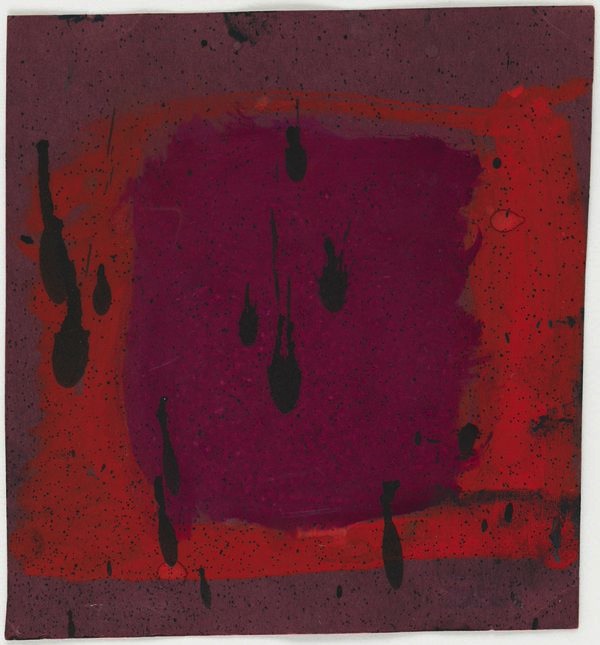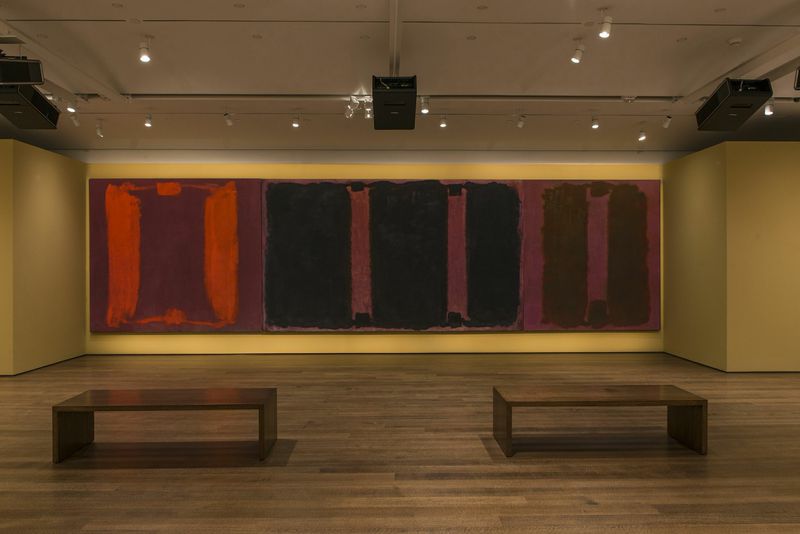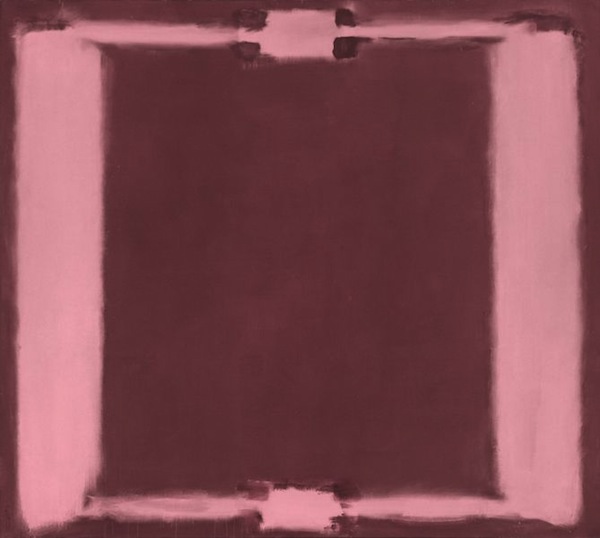Visual Arts Review: Mark Rothko’s Harvard Murals — Splendidly Revived
Harvard’s team of magicians didn’t just bring the Rothko murals back to life, they did so in a way that makes it seem that the paintings had never been interred to begin with.

Mark Rothko, Untitled (Study for Harvard Mural) (verso), c. 1961. Opaque watercoloron purple construction paper. Photo: Harvard Art Museums, © President and Fellows of Harvard College.
By Franklin Einspruch
Mark Rothko’s Harvard Murals (November 16 through July 26, 2015) at the newly reopening Harvard Art Museums is a story about paint. Paint is essentially a mixture of color and glue: a soluble material chosen for its hue and a binder that fixes it to a vertical support. Yet this base matter served as the main vehicle for pictorial culture in the Western world for over five centuries, beginning with the rise of the fresco mural in the late 1300s and continuing until the twentieth-century elimination of the image. By then it had become apparent that paint itself meant something, that paint itself was pictorial culture, that paint itself could convey the humanistic aspirations that had been the concern of art since Giotto. In the early 1960s, when Harvard University commissioned Mark Rothko to provide paintings for a reception hall on the top floor of its new Holyoke Center, he had seen as deeply into the mysteries of paint as anyone.
Rothko was a craftsman. The Harvard murals are painted in egg tempera, colors suspended acrylic copolymer, and distemper, in which pigments are mixed into animal hide glue, usually rabbit. Hide glues are an ancient material, and for a long time distemper was the preferred medium for scenic painting in the theater. (Vuillard turned to distemper after his involvement in theatrical efforts in Paris.) Hide glue was also long used in furniture joinery because it’s rewettable, allowing, say, a broken chair leg to be unglued and replaced.
Distemper gave Rothko an unevenly dispersed paint that evinced brushstrokes even when thinly applied. It then dried quickly, allowing the color to build up in veils. Distemper dries without the slightest gloss, which is why it was useful for scenic painting, and all the more suitable for a wall-size work like the one Rothko envisioned, in which glare would have destroyed the total effect.
The Harvard commission was the only one of three that Rothko had installed under his supervision. He chose a greenish ochre for the walls that contrasted with the mainly red canvases. (Red had come to dominate the painter’s attention in the ’60s.) He arrived with the required works and one extra, as was his practice in these big commissions, and chose the best combination in situ.
They were worked up from sketches in gouache on colored paper through which he figured out an image, that of columns joined by lines at top and bottom, each line punctuated in the center with a block. I use architectural terms because their effect is of a mighty form of stone rendered diaphanous in the hot, crimson atmosphere. These little studies are on display in the Harvard exhibition, and they reveal a kind of premeditation that we don’t always associate with the giants of abstract expressionism. They also show the artist reaching back, subtly, into a vocabulary of images from earlier in his career, when he was stacking discrete shapes up in a foreground and treating the background as air.
Three canvases are abutted into a triptych over thirty feet wide, and two more large canvases face them. Each of them employs the aforementioned image, if I may be forgiven for calling it that. The leftmost one in the triptych glows as if illuminated. The one on the right is a drab olive, which sinks into diminishing contrast with the wall. Read left to right, the implication is of containment, diminution, and death. Read the other way – the artist was the child of a rabbi, after all – it implies a vibrant dawning. The emotional impact is as grand as the physical scale.

Mark Rothko’s Panel One, Panel Two, and Panel Three (Harvard Mural Triptych), with restored colors using light from digital projectors. Photo: Peter Vanderwarker, © President and Fellows of Harvard College.
Unfortunately, Rothko chose as his crimson a pigment called Lithol Red. For decades after its first synthesis, Lithol was thought to be a stable color. In fact, in certain cases it is, but not if you mix it with animal hide glue. In that case it becomes reactive to light, such as that which poured daily through the floor-to-ceiling windows on the top floor of the Holyoke Center. Fleshy pink passages were turned the color of campfire ash. Scarlet fields degenerated into navy-tinged soot.
Distemper, you’ll recall, remains water-soluble after it dries. This obviated the usual conservation measure in this case, repainting, which would have destroyed the vigorously brushed skeins of pigment. Rothko died in 1970, and by the end of that decade the paintings were deemed unexhibitable and unrecoverable, and were all but shunted into the darkness. (They were in fact exhibited a couple of times in the following decades with provisos that they looked quite unlike they did when Rothko finished them.)
In 2001, various Rothko experts started wondering if new technology could be used to bring the paintings back to a semblance of their old selves. The idea was to project a compensatory image onto them somehow so that color in the light would replace the color lost from the paint. In broad outline the idea was simple. The details that went into making it manifest, though, were logistically brutal.
The first question was what the original paintings looked like. They had been documented in the form of Ektachrome slides, which deteriorate in their own peculiar way, but we have so much of them around that we can reason about the deterioration. In particular, the cyan drops off over time. It’s also a little too red to begin with; photographed vacationers look a little merrier for having some rosiness injected into their skin. (Believe it or not, this is now done digitally in many modern cameras. Check your settings.) With these clues and the example of contemporaneous Rothkos that hadn’t faded, conservators arrived at target images.

Mark Rothko, Panel Five (Harvard Mural), 1962. Photo: Digitally restored scan of a 1964 Ektachrometransparency, Harvard Art Museums, © President and Fellows of Harvard College
The next task was to engineer not just projections but projectors from scratch. Copies of the paintings were made for experimentation, experts on digital imaging and computational photography were brought in, and an intramural conversation between restorers, chemists, and image scientists rumbled intensely throughout the development process.
The result is a marvel. The murals are hung in the new gallery on walls painted the green-ochre chosen by the artist for the original site. Five suitcase-sized projectors, hanging from the ceiling and totally inaudible, throw the necessary image on the paintings. A team of magicians couldn’t have concocted a more effective illusion. The gallery isn’t a light show, it’s an apparently normal room with big paintings in it. Harvard didn’t just bring the Rothko murals back to life, they did so in a way that seems that they were never interred to begin with.
They are on the level of the rest of Rothko’s final decade, solemn, sublime, and enveloping. It’s unfashionable to talk about art this way, but they are as if a great truth had been put ineffably on the record. While Harvard promises that it will share the technical knowledge that went into these machines with all who need it, for now, this is the only place in the world where they are working their spell, mending a tragic rip in modern art history.
Franklin Einspruch Franklin Einspruch is a Boston-based artist and writer. His website is einspruch.com; follow him on Twitter @franklin_e.

Just saw these beautiful paintings today. Exactly as you describe them. Thank you so much for the technical insight into his use of pigments and binders.
Great piece on the Rothkos. One other thing to mention: the light projectors will be turned off every day from 4 to 5 (that’s what I was told) so if you go before then, you can see what a difference the light makes.
Great piece, I really enjoyed reading about these pieces and the deception of color changes over time. It’s amazing that they were able to recreate the original color scheme for these works, which is really crucial since color is their main feature. Quite an amazing result. Thanks for the feature!
Do they ‘look’ similar to how they were supposed to? Perhaps. But the projected light kills them. As I’ve written elsewhere, the museum has spent millions changing them from art to artifact. Compare them to the Rothko’s outside the room, which retain their warmth. Tip to viewers: go after 4 p.m. when they turn the machines off, or use your body to block the light.